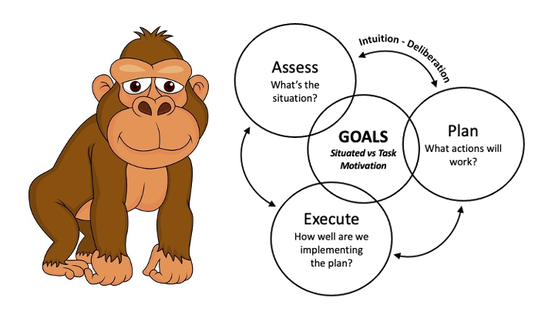|
Goals require staying motivated as we juggle multiple decisions in pursuit of what we are trying to achieve. A.P.E. is a way to think about these decisions in order to improve performance. As a natural model, A.P.E. describes decision making in action, with a focus on how we experience decisions as we strive towards our goals. With A.P.E., goals are a central feature, requiring motivation as we assess, plan, and execute. Each component can be experienced at an intuitive level, as well as through conscious deliberation. This adds an element of volition or personal agency, with goals developing out of prior experiences, as well as established principles, values, and beliefs. This creates a different foundation than rational or mechanistic models which largely ignore individual or intrinsic differences in motivation. Assess To assess means to try to make sense of a situation as we engage in mental contrasting, thinking about where we are in contrast to a potential future state. This potential future may invoke a range of emotions of varying intensity, such as desire or fear. This creates situated motivation. And this imagined future, establishes a situated goal that becomes the focus of our efforts. When we assess, we ask ourselves, “Is the situation familiar? What are the relevant cues and is there anything unexpected going on?” This includes situational factors like missing information or time pressure. For motivation, this is important, as how a goal is situated provides both direction and a sense of the effort required. Plan
As you assess, you are also selecting or creating a plan. This involves task motivation, a type of subgoal as you focus on any actions required to achieve the more distant, situation based goal. You ask, “What action(s) will work?” With a familiar situation, you can rapidly select a plan that has worked in the past. However, in a situation that is less familiar, you may lack confidence in your ability to execute. Therefore, you begin to deliberately reassess the situation, gathering more information as you seek to modify an existing plan or develop a new plan that is “workable” or “good enough”. This means that we can be motivated by a situation, but still fail to act. Execute If a plan is “workable”, you begin to test your plan in the real world, you execute the plan in an effort to achieve the goal. This will give you valuable feedback, increasing or decreasing goal-related motivation. As you execute you naturally reflect on your progress, monitoring how well you are implementing the plan, allowing you to update the situation, and make adjustments to your plans as the situation evolves. Intuition and Deliberation Another aspect of decision making is the role of experience. The less experience you have, the more likely a situation will be unfamiliar. And in an unfamiliar situation you will naturally need to slow down, taking time to deliberate. Compared to a familiar situation, it will take more time to assess, to develop a plan, and to execute. On the other hand, as you gain experience, you can quickly recognize key aspects of a situation, allowing for very rapid, intuitive decisions. Regardless, it is not the case that you either use intuition or deliberation. We use both, requiring less deliberation as we gain experience. Working Together It is important to keep in mind that APE is not a cyclical process where you first assess, then plan, then execute. Instead the components work together, similar to how you might have a computer with multiple processors working in parallel, or how your lungs, heart, and brain function as a system. This means each component influences the other components simultaneously. While driving a car for instance, you are assessing, while planning, while executing, juggling multiple decisions to reach your destination. Note: This is different than the 2018 version of A.P.E. which was presented as a cyclical process. Summary The bottom line, is that goal-oriented decision making focuses on how we experience decision making in action, including the role of motivation. And A.P.E. is a model of decision making that describes how we assess, plan, and execute in pursuit of our goals. To improve performance then, each component can be seen as a point of leverage for us to explore. When making decisions, we can take a look at each component and discover ways to better assess, to better plan, and to better execute. Acknowledgements The concepts of goal-oriented decision making and the A.P.E. model were developed out of various areas of research, including goal theory, naturalistic decision making, and social cognitive theory. The works of Albert Bandura, Gary Klein, Bobby Hoffman, Edwin Locke, Gary Latham, Brian Moon, Peter Gollwitzer, and Gabriele Oettingen have been instrumental in the foundation of these concepts.
0 Comments
Your comment will be posted after it is approved.
Leave a Reply. |
Authors
Richard Feenstra is an educational psychologist, with a focus on judgment and decision making.
(read more) 
Bobby Hoffman is the author of "Hack Your Motivation" and a professor of educational psychology at the University of Central Florida.
(read more) Archives
April 2023
Categories |

 RSS Feed
RSS Feed
